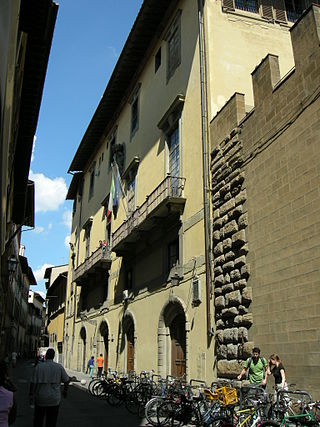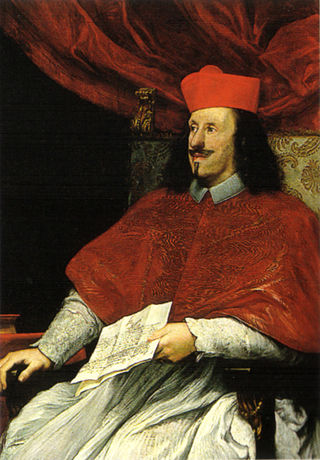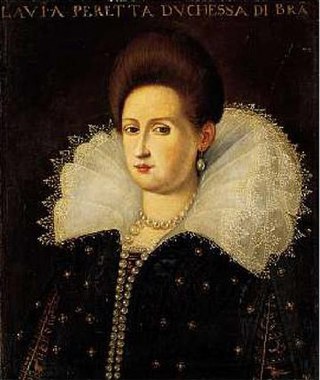
The House of Medici was an Italian banking family and political dynasty that first consolidated power in the Republic of Florence under Cosimo de' Medici during the first half of the 15th century. The family originated in the Mugello region of Tuscany, and prospered gradually until it was able to fund the Medici Bank. This bank was the largest in Europe during the 15th century and facilitated the Medicis' rise to political power in Florence, although they officially remained citizens rather than monarchs until the 16th century.

Cosimo I de' Medici was the second and last duke of Florence from 1537 until 1569, when he became the first grand duke of Tuscany, a title he held until his death.

Cosimo III de' Medici was Grand Duke of Tuscany from 1670 until his death in 1723, the sixth and penultimate from the House of Medici. He reigned from 1670 to 1723, and was the elder son of Grand Duke Ferdinando II. Cosimo's 53-year-long reign, the longest in Tuscan history, was marked by a series of laws that regulated prostitution and May celebrations. His reign also witnessed Tuscany's deterioration to previously unknown economic lows. In 1723, when Cosimo died, he was succeeded by the younger of his two surviving children, Gian Gastone.

Ferdinando II de' Medici was grand duke of Tuscany from 1621 to 1670. He was the eldest son of Cosimo II de' Medici and Maria Maddalena of Austria. He was remembered by his contemporaries as a man of culture and science, actively participating in the Accademia del Cimento, the first scientific society in Italy, formed by his younger brother, Leopoldo de' Medici. His 49-year rule was punctuated by the beginning of Tuscany's long economic decline, which was further exacerbated by his successor, Cosimo III de' Medici. He married Vittoria della Rovere, a first cousin, with whom he had two children who reached adulthood: the aforementioned Cosimo III, and Francesco Maria de' Medici, Duke of Rovere and Montefeltro, a cardinal.

Cosimo II de' Medici was Grand Duke of Tuscany from 1609 until his death. He was the elder son of Ferdinando I de' Medici, Grand Duke of Tuscany, and Christina of Lorraine.

Ferdinando I de' Medici, Grand Duke of Tuscany was Grand Duke of Tuscany from 1587 to 1609, having succeeded his older brother Francesco I, who presumably died from malaria.

Francesco I was the second Grand Duke of Tuscany, ruling from 1574 until his death in 1587. He was a member of the House of Medici.

Giuseppe Maria Crespi, nicknamed Lo Spagnuolo, was an Italian late Baroque painter of the Bolognese School. His eclectic output includes religious paintings and portraits, but he is now most famous for his genre paintings.

Justus Sustermans, Joost Sustermans or Suttermans, his given name Italianised to Giusto, was a Flemish painter and draughtsman who is mainly known for his portraits. He also painted history and genre paintings, still lifes and animals.

Leopoldo de' Medici was an Italian cardinal, scholar, patron of the arts and Governor of Siena. He was the brother of Ferdinando II de' Medici, Grand Duke of Tuscany.

Ferdinando de' Medici was the eldest son of Cosimo III de' Medici, Grand Duke of Tuscany, and Marguerite Louise d'Orléans. Ferdinando was heir to the Grand Duchy of Tuscany, with the title Grand Prince, from his father's accession in 1670 until his death in 1713. He is remembered today primarily as a patron of music. An excellent musician himself, he attracted top musicians to Florence and thus made it an important musical center. Through his patronage of Bartolomeo Cristofori, Ferdinando made possible the invention of the piano.

The Teatro della Pergola, sometimes known as just La Pergola, is a historic opera house in Florence, Italy. It is located in the centre of the city on the Via della Pergola, from which the theatre takes its name. It was built in 1656 under the patronage of Cardinal Giancarlo de' Medici to designs by the architect Ferdinando Tacca, son of the sculptor Pietro Tacca; its inaugural production was the opera buffa, Il potestà di Colognole by Jacopo Melani. The opera house, the first to be built with superposed tiers of boxes rather than raked semi-circular seating in the Roman fashion, is considered to be the oldest in Italy, having occupied the same site for more than 350 years.

Vittoria della Rovere was Grand Duchess of Tuscany as the wife of Grand Duke Ferdinando II. She had four children with her husband, two of whom would survive infancy: the future Cosimo III, Tuscany's longest-reigning monarch, and Francesco Maria, a prince of the Church. At the death of her grandfather Francesco Maria della Rovere, she inherited the Duchies of Rovere and Montefeltro, which reverted to her second son, Francesco Maria, at her death. She was later entrusted with the care of her three grandchildren. Her marriage brought a wealth of treasures to the House of Medici, which can today be seen in the Palazzo Pitti and the Uffizi Gallery in Florence.

Francesco Maria de' Medici was a member of the House of Medici. He was successively a Governor of Siena, cardinal and later the heir of the duchy of Montefeltro by right of his mother.

Don Antonio de' Medici was the only son of Francesco I de' Medici, Grand Duke of Tuscany and his mistress Bianca Cappello. He was a minor figure at the Grand Ducal Medici court.

The Biblioteca Riccardiana is an Italian public library under the aegis of the Ministry of Culture, located inside the Palazzo Medici Riccardi at 10 Via de’ Ginori in Florence, in the neighborhood comprising the Mercato Centrale and the Basilica di San Lorenzo. Its main feature is preserving books collected by members of the Riccardi family and making them available in the very same rooms that were originally dedicated to that purpose. So, still today the library boasts the magnificent bookshelves, neatly carved and gilded, that create the atmosphere of a late-seventeenth-century patrician library, whose main features have all been kept intact.

Innocenzo Cibo was an Italian cardinal and archbishop.

Giancarlo de' Medici was an Italian cardinal of the House of Medici. He was the second son of Grand Duke Cosimo II of Tuscany and his wife, Maria Maddalena of Austria, and the brother of Ferdinando II de' Medici, Grand Duke of Tuscany.

Flavia Damasceni Peretti, Duchess of Bracciano was an Italian noblewoman, niece of Pope Sixtus V and duchess consort of Bracciano as wife of Virginio Orsini. She is also known as the patroness of several poets, writers and musicians.

Ciro Alidosi was a 16th-century Italian nobleman, diplomat, and lord of Castel del Rio, known for his service to the Medici and his controversial governance.





















